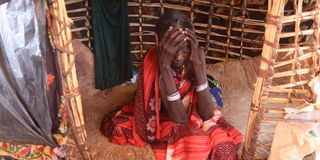Ethiopians fleeing famine find more of the same in Marsabit camp

Sori Boru, 68, at her hut at the Lataka migrants camp. She is one of the elderly persons living in deplorable conditions at the camp.
When an emergency camp for migrants opened in Lataka, Moyale sub-county, three months ago, it became a haven for more than 4,000 Ethiopians fleeing their country because of drought and famine.
They wanted an ‘immigrant-friendly place, in a considerate and timely manner’.
But with each coming sunrise and sunset, the solace, healing and hope they anticipated becomes a mirage, with despondency setting in.
They cite deplorable living conditions, especially for women, children and the elderly.
“We have lost all our livelihoods and solely depend on NGOs for relief aid, but even the little food rations we got are nearly depleted. We fear for our future and have no hope left,” said Galgallo Jarso Kin, 70, a community elder.
He said Ethiopians at the camp fled from Melbana, Lich, Magadho, and Godholoni villages, more than 100km away in neighbouring Ethiopia, to seek refuge and permanent residency in Kenya.

Mzee Boru Sora shows the huts the Ethiopian migrants live in at Lataka Uran area in Moyale sub-county on November 24, 2022.
In the first influx, some 554 families crossed the border to Kenya and they were warmly received by Uran residents.
An additional 200 households came to the camp, worsening a humanitarian crisis with an outbreak of contagious diseases such as cholera and tuberculosis.
At the camp, the Nation witnessed women busy fetching poles and other building materials, while others dug holes and erected small huts.
Those who came earlier were lucky to receive 152 tents to cover their huts and shelter themselves against the biting cold at night and sweltering heat during the day.
The majority of the 4,270 people at the camp shelter under bare-roofed huts that are equivalent to sleeping or sitting in the open fields.
Mzee Jarso is among the immigrants whose sole reason to continue living, he says, was his attachment to his over 300 cattle that succumbed to drought and nearly caused him to go berserk.

Mzee Abdub Halaqe, 70, at his hut at Lataka migrants camp on November 24, 2022. He is one of the elderly persons living in deplorable conditions at the camp.
We were told that sometimes he plunges into fits of soliloquy because of mental illness caused by his massive loss.
The Ethiopians escaped death by starvation only to again come face to face with it in Kenya.
When they first arrived, each household received at least 10kg of maize and beans and a bundle of maize flour from humanitarian agencies such as the World Food Programme, World Vision and the Kenya Red Cross Society.
The little stock they had is nearly getting depleted and their children and the elderly, who only relied on porridge, are now staring death in the eye.
They appealed to NGOs and the Kenyan and Ethiopian governments to come to their aid.
Boru Sora recounted that they lacked clean water as the only available pond had little water that could sustain them for the next two weeks if it did not rain.

An elderly woman seeking shelter under the sweltering heat at the migrants camp at Lataka area on November 24, 2022.
The water in the nearest borehole, around four kilometres away, was too saline for human consumption and domestic use.
Of the 854 households, none has a toilet or open latrine, leaving them with only one option – open defecation, which jeopardises their health.
The immigrants now fear an impending cholera outbreak.
Women, the elderly and children also face other dangers when they answer the call of nature in the bush.
They claimed that one elderly person died recently of a disease whose symptoms were akin to those of kala-azar. Public health officers were called in to collect samples, and forensic tests were underway.

A woman covers her newly made hut with a blanket at Lataka in Moyale sub-county on November 24, 2022. The migrants are living in deplorable conditions.
Galmo Dadacha Galgallo and Jilloh Abduba raised concerns about the general welfare of women and children.
Most of the children and elderly are malnourished.
When we entered some of the huts, we met emaciated elderly persons who had to be helped with nearly everything.
Most women have been turned into beggars, trekking over six kilometres daily appealing for food from locals so that their children do not starve to death.

A woman cooks at the migrants camp at Lataka area in Moyaye sub-county on November 24, 2022.
When we drove from Lataka, where the camp is situated, to Uran shopping centre, about four kilometres, and Walda shopping centre, about six kilometres away, we met haggard-looking women returning to camp in the sweltering midday heat.
Marsabit County Commissioner Paul Rotich acknowledged the presence of the Ethiopians in Kenya when we reached him for comment on the conditions at the camp.
He said Kenya and Ethiopia were in talks to determine the fate of the migrants.
But he insisted that there was not a crisis in Ethiopia to warrant permanent residency for the migrants in Kenya.





